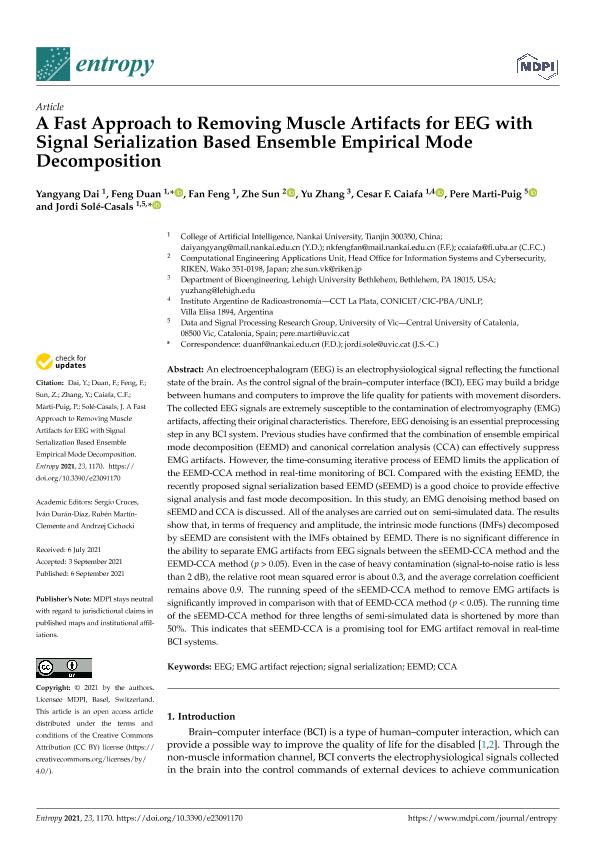Artículo
A fast approach to removing muscle artifacts for EEG with signal serialization based Ensemble Empirical Mode Decomposition
Dai, Yangyang; Duan, Feng; Feng, Fan; Sun, Zhe; Zhang, Yu; Caiafa, César Federico ; Marti Puig, Pere; Solé Casals, Jordi
; Marti Puig, Pere; Solé Casals, Jordi
 ; Marti Puig, Pere; Solé Casals, Jordi
; Marti Puig, Pere; Solé Casals, Jordi
Fecha de publicación:
09/2021
Editorial:
Molecular Diversity Preservation International
Revista:
Entropy
ISSN:
1099-4300
Idioma:
Inglés
Tipo de recurso:
Artículo publicado
Clasificación temática:
Resumen
An electroencephalogram (EEG) is an electrophysiological signal reflecting the functional state of the brain. As the control signal of the brain-computer interface (BCI), EEG may build a bridge between humans and computers to improve the life quality for patients with movement disorders. The collected EEG signals are extremely susceptible to the contamination of electromyography (EMG) artifacts, affecting their original characteristics. Therefore, EEG denoising is an essential preprocessing step in any BCI system. Previous studies have confirmed that the combination of ensemble empirical mode decomposition (EEMD) and canonical correlation analysis (CCA) can effectively suppress EMG artifacts. However, the time-consuming iterative process of EEMD limits the application of the EEMD-CCA method in real-time monitoring of BCI. Compared with the existing EEMD, the recently proposed signal serialization based EEMD (sEEMD) is a good choice to provide effective signal analysis and fast mode decomposition. In this study, an EMG denoising method based on sEEMD and CCA is discussed. All of the analyses are carried out on semi-simulated data. The results show that, in terms of frequency and amplitude, the intrinsic mode functions (IMFs) decomposed by sEEMD are consistent with the IMFs obtained by EEMD. There is no significant difference in the ability to separate EMG artifacts from EEG signals between the sEEMD-CCA method and the EEMD-CCA method (p > 0.05). Even in the case of heavy contamination (signal-to-noise ratio is less than 2 dB), the relative root mean squared error is about 0.3, and the average correlation coefficient remains above 0.9. The running speed of the sEEMD-CCA method to remove EMG artifacts is significantly improved in comparison with that of EEMD-CCA method (p < 0.05). The running time of the sEEMD-CCA method for three lengths of semi-simulated data is shortened by more than 50%. This indicates that sEEMD-CCA is a promising tool for EMG artifact removal in real-time BCI systems.
Palabras clave:
EEG
,
EMG artifact
,
signal serialization
,
EEMD
Archivos asociados
Licencia
Identificadores
Colecciones
Articulos(IAR)
Articulos de INST.ARG.DE RADIOASTRONOMIA (I)
Articulos de INST.ARG.DE RADIOASTRONOMIA (I)
Citación
Dai, Yangyang; Duan, Feng; Feng, Fan; Sun, Zhe; Zhang, Yu; et al.; A fast approach to removing muscle artifacts for EEG with signal serialization based Ensemble Empirical Mode Decomposition; Molecular Diversity Preservation International; Entropy; 23; 1170; 9-2021; 1-16
Compartir



